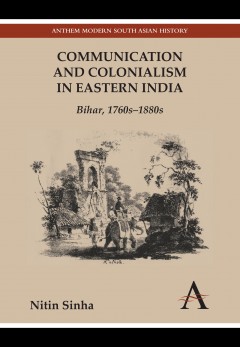Communication and Colonialism in Eastern India
Bihar, 1760s–1880s
By Nitin Sinha
- About This Book
- Reviews
- Author Information
- Series
- Table of Contents
- Links
- Podcasts
About This Book
Communication and Colonialism in Eastern India: Bihar, 1760s–1880s' departs from the dominant scholarship in South Asian history that focuses narrowly on railways, and instead argues that any discussion of railway-generated changes needs to see such changes, at least up to the 1880s, as situated amidst existing patterns and networks of circulation within which roads and ferries were crucial. The volume also offers a detailed exploration of early colonial policies on road building and ferry improvement – an area that has hitherto remained unexplored.
Just as the new development of steam technology required and necessitated ‘lateral growth’ alongside the older technologies, so too were trade linkages marked by the interconnectedness of local and supra-local ties in which the world of peddlers intersected with that of native merchants and capitalist sahibs. This volume contends that the history of colonial communication is not a story of ‘displacement’ alone – either of one means by another or of one group by another – but also of realignment. Combining the understanding of production of knowledge about routes with the ways the practice of surveying and mapping led to territorial construction of the national space of India, this book reinterprets the ‘colonial state–space’ as constituting a series of layered components, both of ‘inherited spaces and networks’ from pre-colonial times and of the processes of objectification that colonial rule initiated.
The aim of this volume is to contribute to the ‘history of social spaces’, a new field of study in which neither cultural nor economic discourse is overridden by the other. This is achieved via a micro-historical study of local circulatory regimes, together with an exploration of colonial and imperial cultural discourses on communications.
Reviews
‘[This is] a book which is not only nuanced and convention challenging, but also successful in simultaneously navigating several strands of historical investigation. There is something in here for the historian of transport, as there is for the historian of cartography, the economic historian and the historian of print culture. [It is] likely to become important reading for scholars of colonial South Asia.’ —Amelia Bonea, ‘H-Soz-Kult’
‘Dr Sinha provides a fascinating study of transportation and communication in Bihar. This book moves, and therefore moves all of us, beyond the published literature. The periodization, the 1760s to the 1880s, enables Sinha to identify better the continuities and discontinuities within the circulation of people, goods and ideas in India before and after the 1850s advent of railways.’ —Professor Ian J. Kerr, University of Manitoba
Author Information
Nitin Sinha is a research fellow at the Zentrum Moderner Orient (Centre for Modern Oriental Studies) in Berlin. His current work focuses on the socio-historical dimensions of the River Ganga in India. He has published on issues of transport and the ‘Mutiny’ of 1857, mobility and criminality, and railway labour movements in nineteenth- and twentieth-century colonial India.
Series
Anthem Modern South Asian History
Anthem South Asian Normative Traditions Studies
Table of Contents
Abbreviations; List of Illustrations; Introduction; Chapter 1. From Affective Forms to Objectification: Spatial Transition from Pre-colonial to Colonial Times; Chapter 2. India and its Interiors; Chapter 3. Going into the Interiors; Chapter 4. Knowing the Ways; Chapter 5. Controlling the Routes; Chapter 6. Changing Regime of Communication, 1820s–60s; Chapter 7. Of Men and Commodities; Chapter 8. The Wheels of Change; Conclusion; Bibliography; Index
Links
Stay Updated
Information
Latest Tweets



